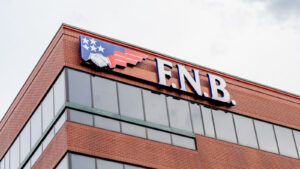
The banking sector is not completely out of the woods from the industry crisis experienced earlier this year, but if you are a value investor, this works to your advantage investing in bank stocks.
A myriad of concerns, including the steep rise in interest rates (affecting the value of bank loan and bond portfolios), big exposure to the commercial real estate sector (currently in meltdown mode), as well as the possibility of a recession next year, continue to weigh on bank stock valuations.
This has resulted in some banking names getting pushed down to prices that more than factor-in these risks. Today you can buy shares in scores of regional banks trading at very discounted forward valuations. Think single-digit price-to-earnings ratios, including a few trading at low single-digit multiples.
That’s not all. These banks also trade at sharp discounts to book value. In a few situations, these discounts exceed 30%. Having said this, I wouldn’t go out and just buy every banking stock that looks cheap on a screener.
Rather, I would only consider the undervalued banking stops with reduced “value trap” risk. That’s the situation here with these seven.
Associated Banc-Corp (ASB)

Based in Green Bay, Wisconsin, Associated Banc-Corp (NYSE:ASB) provides commercial and consumer banking services in its home state, as well as in adjacent states, Illinois and Minnesota. At current prices, ASB trades for only 7.5 times forward earnings.
In terms of discount to book value, with ASB stock, said discount comes in at 36%. With this sharp discount, at first it may seem like Associated Banc-Corp is very risky, with the market pricing-in an increased likelihood of the aforementioned industry risk affecting the bank’s health/future results.
That may not be the case. Earlier this month, Baird analyst David George upgraded ASB, citing a favorable risk-reward profile. With healthy capital levels, and as 69% of its loan book set to re-price or mature in the coming year, ASB (which also sports a forward dividend yield of 4.96%) could make a comeback, once banking uncertainties subside.
ConnectOne Bancorp (CNOB)

Based in Englewood Cliffs, New Jersey, ConnectOne Bancorp (NASDAQ:CNOB) is a regional bank in the New York and South Florida metropolitan areas.
Among the bank stocks, CNOB is another one that has both a low earnings multiple, as well as trades for a big discount to book value.
CNOB stock trades for around 9 times earnings, with shares trading at a 35% discount to book. ConnectOne Bancorp also pays investors a 17 cent per share quarterly dividend, giving the stock a forward yield of 3.63%. Besides representing deep value, there’s another aspect to ConnectOne that you may find appealing.
As a Gurufocus commentator recently pointed out, CNOB has a hidden fintech asset: business lending marketplace operator BoeFly, which the bank acquired in 2019. Depending on future growth for BoeFly, this segment could in time grow into a much larger enterprise, which ConnectOne could choose to spin-off/sell.
F.N.B. Corp. (FNB)

Pittsburgh, Pennsylvania-based F.N.B. Corp. (NYSE:FNB) is another regional bank that stands out because of a low valuation. FNB’s forward P/E ratio is 7.5, and shares trade at a 32% discount to book value. The stock has a forward dividend yield of 4.3% as well.
So, besides screening well based on valuation metrics, what else makes FNB stock an undervalued bank worth buying? Despite the industry worries, F.N.B. continues to report strong results. Last quarter, earnings per share, increased 30% year-over-year from 30 cents to 39 cents.
While earnings did plateau on a sequential (or quarter-over-quarter) basis, and analysts expect FNB’s earnings to remain flat next year, given the bank’s track record of earnings beats, there could be the potential for greater-than-expected growth in the coming quarters, which may in turn lead to a re-rating for its undervalued shares.
New York Community Bancorp (NYCB)

Compared to the undervalued bank stocks listed above, New York Community Bancorp (NYSE:NYCB) is much more well-known among the investing public. Thanks to a mergers and acquisitions deal entered earlier this year.
As you may recall, this was the bank that purchased much of Signature Bank’s (OTCMKTS:SBNY) assets, when the non-defunct financial institution helped to kick off last March’s banking crisis because of its sudden collapse. Perceived to be a deal highly favorable to the acquirer, NYCB stock has nearly doubled off its 52-week low since they announced the transaction six months back.
Yet even after this rally, NYCB remains cheap. The stock trades at a forward multiple of 8.6. NYCB’s current valuation also represents a more than 20% discount to its book value. With a relatively high dividend yield (5.72%) to boot, NYCB remains appealing as a value play.
Sandy Spring Bancorp (SASR)

Sandy Spring Bancorp (NASDAQ:SASR) is a regional bank operating in the Washington, D.C. metro area. Even among bank stocks, SASR trades at a sharp discount to book value (38%).
SASR stock also trades for just 7.6 times forward earnings and has a forward dividend yield of 6.31%. The market has clearly heavily discounted shares because of banking industry uncertainty. It doesn’t help either that Sandy Spring reported a big drop in profitability for the preceding quarter.
Then again, the fact the bank reported a big one-time gain during the prior year’s quarter played a role in this earnings drop. While SASR is indeed facing issues like falling net interest margin and rising operating costs, the big discount to book provides a margin of safety. With shares already beaten down, it may take just a small amount of “less bad” news to drive a bounce-back for SASR.
Veritex Holdings (VBTX)

Veritex Holdings (NASDAQ:VBTX) owns Veritex Community Bank, which operates in both the Dallas-Fort Worth and Houston metro areas. VBTX trades at a 37% discount to book value, and sports a forward earnings multiple of only 6.8, along with a 4.45% forward dividend yield.
Yet while Veritex reported a big earnings miss last quarter, there’s little else signaling why VBTX stock in particular should trade at such a low valuation, even for a regional bank. In fact, even as earnings took a dip last quarter, the company did make other promising announcements in the earnings release.
CEO C. Malcolm Holland III announced the bank improved its tier 1 capital ratio and decreased its commercial real estate exposure during the period. Perhaps implementing solid risk management measures to ride out today’s industry headwinds, VBTX could have a big rebound as these issues dissipate.
Valley National Bancorp (VLY)

For those familiar with Valley National Bancorp (NASDAQ:VLY), you may find it odd that I’m about to argue VLY is well worth the risk. To those in the know, it may seem obvious why VLY trades for 8.3 times earnings, and at a nearly 30% discount to book value.
Many perceive VLY stock to be high risk, because of the belief that the large regional bank has outsized exposure to commercial real estate. However, as analysts at JP Morgan argued in June, these concerns are likely overblown. According to the analyst team, VLY’s exposure to central business district real estate is far less than perceived.
With this, this may be another one of the regional banks that will successfully ride out today’s troubles. While you wait for shares to potentially bounce back toward prior price levels, you can collect VLY’s 4.82% dividend.
On the date of publication, Thomas Niel did not hold (either directly or indirectly) any positions in the securities mentioned in this article. The opinions expressed in this article are those of the writer, subject to the InvestorPlace.com Publishing Guidelines.






